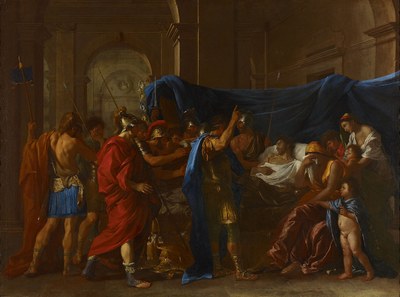Itay Sapir // Representations of the Instant of Death in Early Modern Painting
During my one-month stay at the ZI, supported by a “returning scholar” funding from the Humboldt Foundation, I will work on the introduction and a sample chapter for a book proposal stemming from my research project “Representations of the Instant of Death in Early Modern Painting”. The proposed book traces the evolution of the pictorial representation – and, more often than not, the visual effacement – of the instant of death in Europe between the “High Renaissance” and the end of the seventeenth century. It seeks to show how artistic choices tackling the visual depiction of “death events” (i.e. death taking place, as opposed to the long processes of agony on the one hand and mourning on the other) are manifestations of theoretical, philosophical and anthropological issues crucial to early modern culture as they are still now.
 Among the theoretical themes that images of the moment of death pictorially address, the book will discuss the very concept of an instant and its aporias (considering philosophies of time from Saint Augustine to Henri Bergson); the more specific question (both philosophical and biological) of death, its definitions and its temporality, which is, needless to say, culturally and historically determined; and the vast art-theoretical issues around painting and its fraught relation with time, liveliness and the inanimate.
Among the theoretical themes that images of the moment of death pictorially address, the book will discuss the very concept of an instant and its aporias (considering philosophies of time from Saint Augustine to Henri Bergson); the more specific question (both philosophical and biological) of death, its definitions and its temporality, which is, needless to say, culturally and historically determined; and the vast art-theoretical issues around painting and its fraught relation with time, liveliness and the inanimate.
The historical narrative of the book hinges upon the work of Caravaggio, its central axis, as it were, as the Lombard painter was the first post-Medieval European artist to show sustained interest in the pinpointing of an infinitesimally brief instant of death and in representing it in painting. However, it begins a century earlier with some exceptional artistic experiments of artists such as Michelangelo and Raphael, leading to a few decades of mannerist playful ambiguity; it ends with a few generations of post-Caravaggio artists, some considered followers of Merisi, others seen as his antagonists, and all exemplifying, in relation to the question of the instant of death, the complex reception of the caravaggesque heritage.
Given the particular set of issues painting (and other pictorial media) face when narrating death events, a comparative approach is inevitable; thus, the literary, theatrical, musical and scientific representation of the instant of death in the sixteenth and seventeenth centuries will be discussed as well. After all, the lifetime of Caravaggio, just around the turn of these two centuries, saw the birth of the medium of the opera and the creation of the great Shakespearean tragedies, to name just two artistic fields in which death and its temporalities play a major role.
[Caption: Nicolas Poussin, The Death of Germanicus, 1627, Minneapolis, Minneapolis Institute of Art ]
